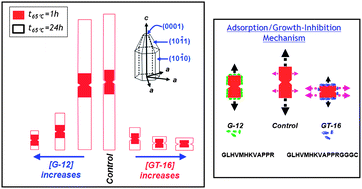Direct evidence of ZnO morphology modification via the selective adsorption of ZnO-binding peptides†
Abstract
Biomolecule-mediated ![[1 with combining macron]](https://www.rsc.org/images/entities/char_0031_0304.gif) 0) planes of
0) planes of ![[1 with combining macron]](https://www.rsc.org/images/entities/char_0031_0304.gif) 0) crystal planes is greater for GT-16 than
0) crystal planes is greater for GT-16 than

* Corresponding authors
a
Biomolecular and Materials Interface Research Group, School of Science and Technology, Nottingham Trent University, Clifton Lane, Nottingham, UK
E-mail:
Carole.Perry@ntu.ac.uk
Biomolecule-mediated ![[1 with combining macron]](https://www.rsc.org/images/entities/char_0031_0304.gif) 0) planes of
0) planes of ![[1 with combining macron]](https://www.rsc.org/images/entities/char_0031_0304.gif) 0) crystal planes is greater for GT-16 than
0) crystal planes is greater for GT-16 than

 Please wait while we load your content...
Something went wrong. Try again?
Please wait while we load your content...
Something went wrong. Try again?
M. Liang, O. Deschaume, S. V. Patwardhan and C. C. Perry, J. Mater. Chem., 2011, 21, 80 DOI: 10.1039/C0JM02124E
To request permission to reproduce material from this article, please go to the Copyright Clearance Center request page.
If you are an author contributing to an RSC publication, you do not need to request permission provided correct acknowledgement is given.
If you are the author of this article, you do not need to request permission to reproduce figures and diagrams provided correct acknowledgement is given. If you want to reproduce the whole article in a third-party publication (excluding your thesis/dissertation for which permission is not required) please go to the Copyright Clearance Center request page.
Read more about how to correctly acknowledge RSC content.
 Fetching data from CrossRef.
Fetching data from CrossRef.
This may take some time to load.
Loading related content
